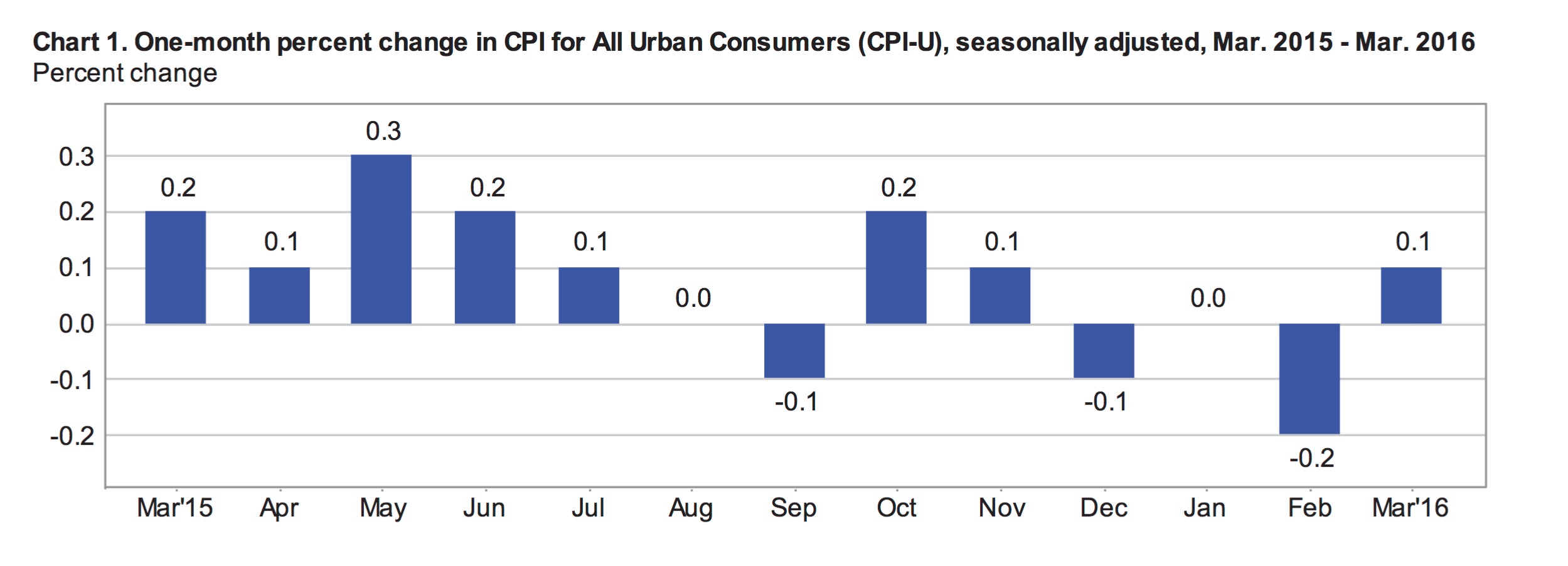Today’s inflation data will be a disappointment to the Federal Reserve as it does not support their intention to raise interest rates in the near term. In the absence of healthy underlying price pressure, the case for economic tightening is weak. According to this morning’s report from the Bureau of Labor Statistics, inflation appears more sluggish than expected.
Headline inflation, as measured by the Consumer Price Index for All Urban Consumers (CPI-U) inched up 0.1% in March on a seasonally adjusted basis and 0.4% without adjustments. For the year ending in March, the CPI-U was up 0.9%, significantly below expectations, which were closer to 1.2% and well below the Fed’s 2% target rate.
Seasonally Adjusted Monthly Inflation
Data was mixed across economic sectors in March as declining food prices largely offset higher energy prices.
The food index fell 0.2% in March to wipe out February’s 0.2% increase in the price of food. Food at home decline 0.5% compared to an increase of 0.2% for the previous month. This is the largest monthly decline in food prices in nearly 7 years. Prices at the grocery store were basically down across the board with the index for ‘other food at home’ being the only one of the six grocery store categories to post higher prices in March. The most significant monthly declines were in prices for eggs, down 5.2% and for fresh fruits and vegetables, down 2.4%. On the other hand, the index for food away from home was up 0.2% in March.
The energy index was higher in March, up 0.9% on a seasonally adjusted basis following a 6.0% drop in February. Higher gas prices, up 2.2% with seasonal adjustments and 10.2% without adjustments, pushed the energy index into positive territory for the month. The gasoline index is still down 20.9% for the year. The transportation index (transportation commodities less motor fuel) fell 0.1% in March.
Prices for many retail consumer discretionary goods weakened in March. The price of household furnishings and supplies dropped 0.2% including a 0.8% decline in the index for appliances. The apparel index was down 1.1% for the month following an increase of 1.6% in February. Recreational commodity prices dropped 0.3% compared to a decline of 0.5% the previous month.
Prices for services pushed higher in March, the index for services less energy services was up 0.2% following three consecutive monthly increases of 0.3%. This index includes shelter, medical care services and transportation services. Shelter prices continued to rise, gaining 0.2% in March. However, the index for lodging away from home fell 1.8% for the month due to declines in hotel and motel rates.
Medical care service prices were 0.1% higher in March, cooling after two month of 0.5% growth. While the cost of health insurance increased 0.4%, most other medical care service costs slipped marginally throughout the month. Transportation services were 0.2% higher including a jump of 2.2% in the index for car and truck rentals.
Seasonally Adjusted Monthly % Change in CPI-U by Category (2016)
| January | February | March | April | May | June | July | |
|---|---|---|---|---|---|---|---|
| All Items | 0 | -0.2 | 0.1 | 0.4 | 0.2 | 0.2 | 0.0 |
| Food | 0 | 0.2 | -0.2 | 0.2 | -0.2 | -0.1 | 0.0 |
| Energy | -2.8 | -6.0 | 0.9 | 3.4 | 1.2 | 1.3 | -1.6 |
| Gasoline | -4.8 | -12.5 | 2.2 | 8.1 | 2.3 | 3.3 | -4.7 |
| Fuel Oil (non seasonally adjusted) | -6.5 | -2.9 | 1.7 | 1.9 | 6.2 | 3.7 | -1.5 |
| Electricity | -0.7 | -0.2 | 0.4 | -0.3 | -0.2 | -0.5 | 0.5 |
| Utilities (piped gas service) | -0.6 | 1.0 | -0.7 | 0.6 | 1.7 | -0.4 | 3.1 |
| Energy Services | -0.7 | 0.1 | 0.2 | -0.1 | 0.2 | -0.5 | 1.0 |
| All Items Less Food and Energy | 0.3 | 0.3 | 0.1 | 0.2 | 0.2 | 0.2 | 0.1 |
| Services Less Energy Services | 0.3 | 0.3 | 0.2 | 0.3 | 0.4 | 0.3 | 0.2 |
| Shelter | 0.3 | 0.3 | 0.2 | 0.3 | 0.4 | 0.3 | 0.2 |
| Transportation Services | 0.4 | 0.2 | 0.2 | 0.7 | 0.3 | 0.3 | -0.2 |
| Medical Care Services | 0.5 | 0.5 | 0.1 | 0.3 | 0.5 | 0.2 | 0.5 |
12-Month Inflation
Prices pushed up 0.9% over the 12-months ending in March, slowing slightly from 1% in February. Core inflation (all items less food and energy) was 2.2% over the 12-month period. Food prices climbed 0.8% over this period. The cost of food at home declined by 0.5%, while the price of food away from home increased by 2.7%.
The energy index was down 12.6% year over year in March. Energy accounts for about 6.4% of the CPI-U. Energy commodity prices fell an annual 21.2% in March, including a 34.8% drop in the cost of fuel oil and a 20.9% drop in gasoline prices. The index for energy services fell 3.3% year over year.
The price of retail goods such as furniture (down 1.2%), appliances (down 3.4%) and apparel (down 0.6%) were lower for the year. The index measuring the price of toys also fell significantly, down 7.6% since March of last year. Over this period, the index for medical care commodities increased by 2.4% including an annual increase of 3.6% in the price for prescription drugs.
Regional Inflation
Across the country, inflation has been higher in cities with over 1.5 million residents and fewer than 50,000 residents compared to mid-size urban areas. Inflation has also been significantly stronger in western states over the past year. Prices climbed 1.7% in the Los Angeles area but dropped 0.2% in Cleveland year over year.
| Urban Population | 12-month | August |
|---|---|---|
| over 1.5 million | 1.3% | 0.1% |
| 50,000 to 1.5 million | 0.7% | 0.1% |
| under 50,000 | 0.8% | -0.1% |
| Urban Regions | 12-month | August |
|---|---|---|
| Northeast | 1.1% | 0.1% |
| Midwest | 0.6% | 0.1% |
| South | 1.0% | 0.1% |
| West | 1.6% | 0.1% |
Outlook for the Federal Reserve
There is growing evidence that the US economy is on solid ground and the Federal Reserve is waiting for the opportunity to continue raising interest rates. However, raising rates without clear evidence of inflationary pressure would be imprudent. The growing domestic economy now faces headwinds from slow growth abroad, especially in China. If the dollar continues to fall, prices of imported goods will climb and inflation could tick up in the coming months. Also, oil prices will eventually rebound, which will contribute to higher rates of inflation in the US. The fed will likely wait for evidence of these price pressures before reigning in economic growth by hiking interest rates.





